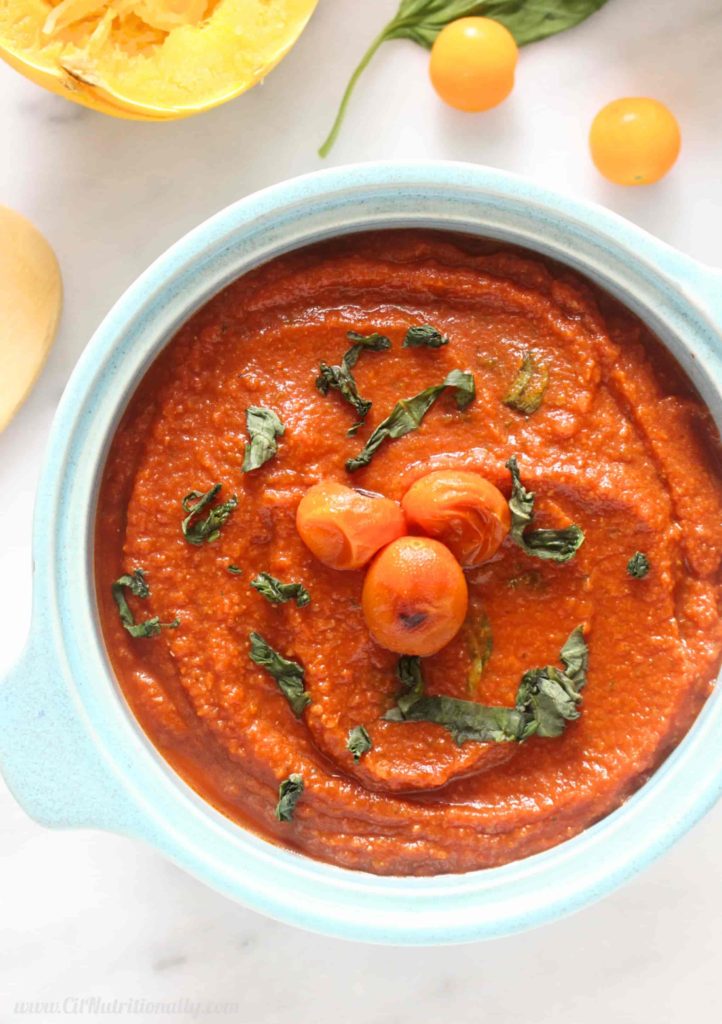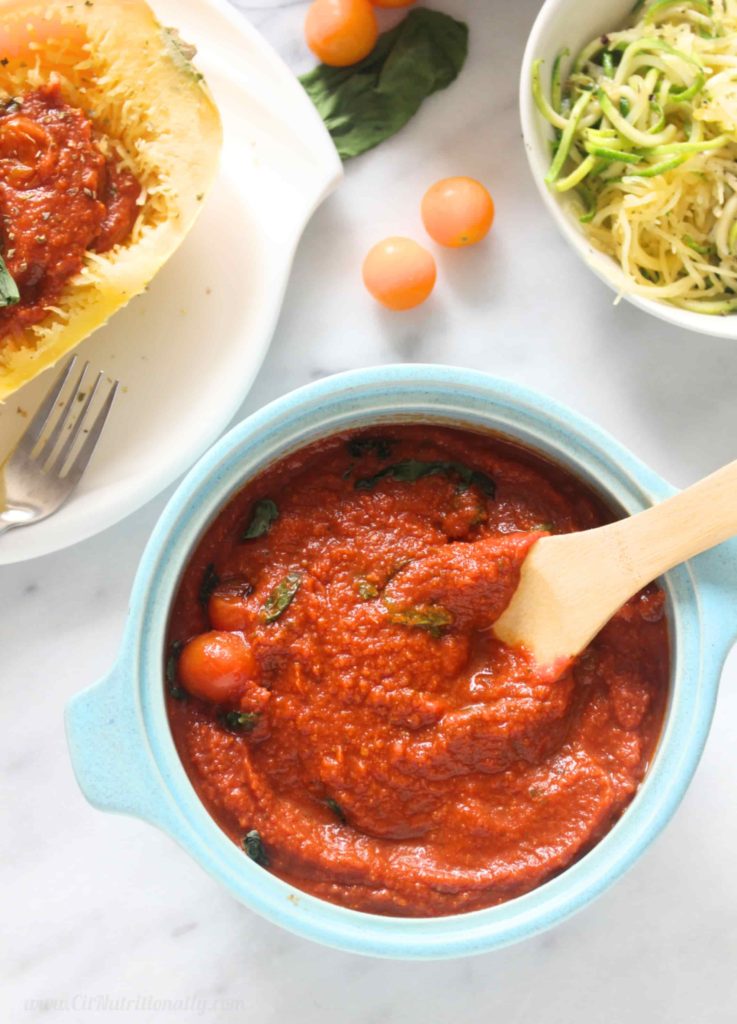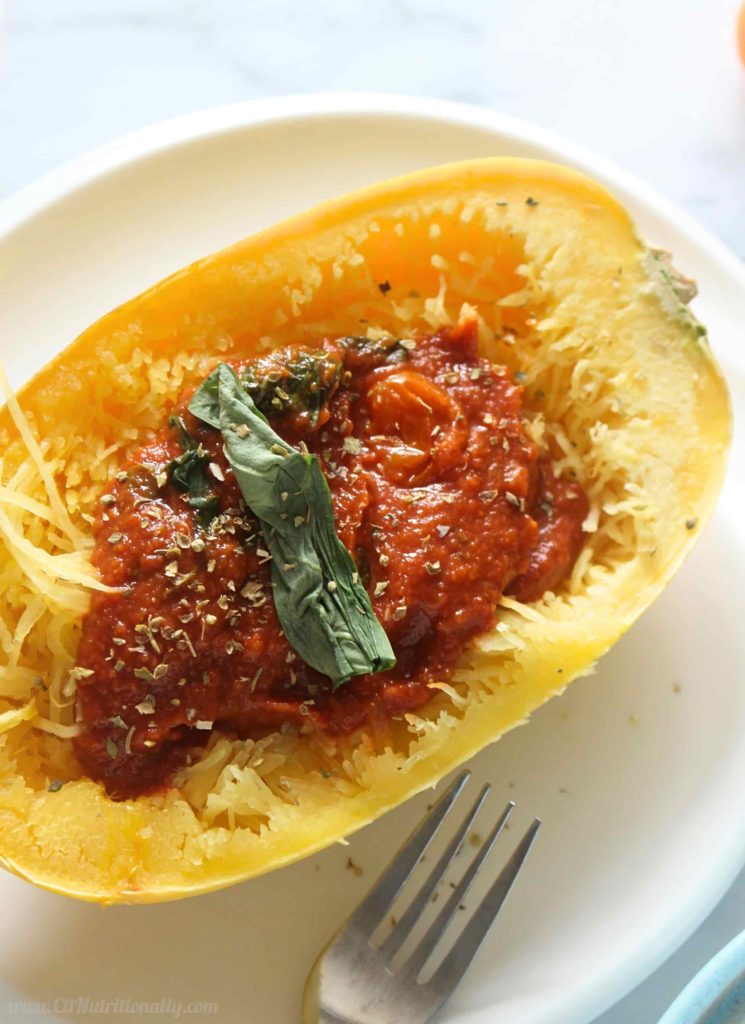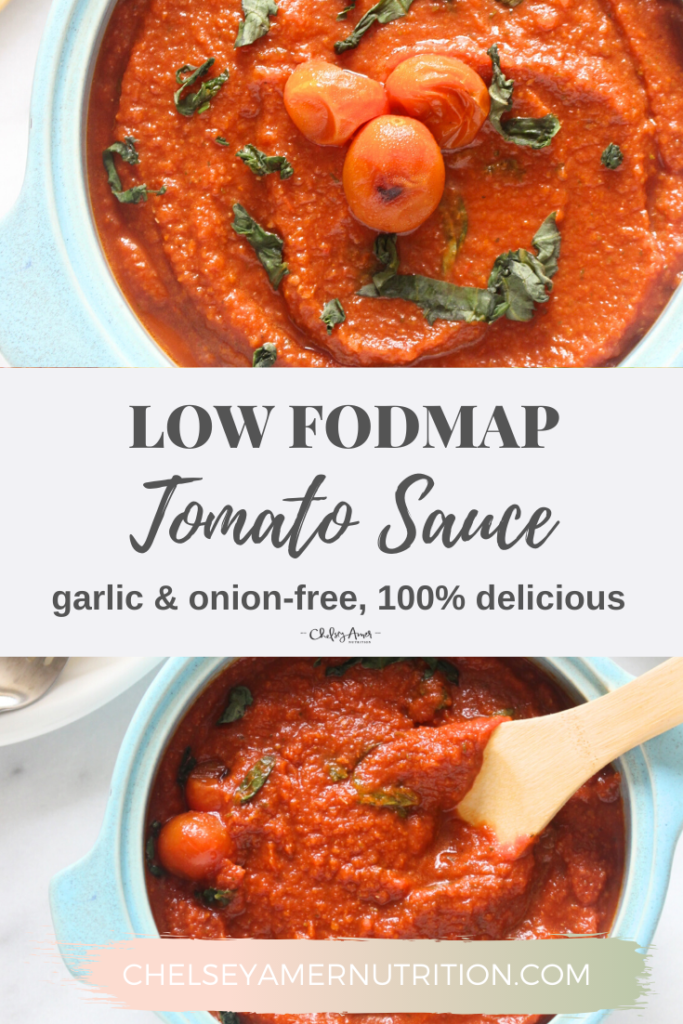Low FODMAP Tomato Basil Sauce
This Low FODMAP Tomato Basil Sauce is made without garlic and onions to make it easy to digest. It’s perfect on pasta, spaghetti squash, zoodles, or any way you’d use jarred tomato sauce.
Dairy Free, Gluten Free, Nut Free, Soy Free, Egg Free, Garlic & Onion Free

I don’t know if I’ve ever been so excited to share a recipe!
You see, this recipe was life-changing while I was working my way through my medically-necessary low FODMAP diet. FOD-what, you may be asking yourself…?
Well, over the past two months, I’ve been experimenting with a diet low in fermentable carbohydrates — Fermentable Oligosaccharides, Disaccharides, Monosaccharides and Polyols — to help alleviate some bloating and stomach pain associated with Irritable Bowel Syndrome (IBS). It’s something I’ve been meaning to write about for quite some time, but just haven’t gotten around to… until this week!
What is Irritable Bowel Syndrome?
In full disclosure, I’m not a gastrointestinal dietitian. BUT, having many of my own GI struggles, I’ve learned a thing or two about IBS, or irritable bowel syndrome (outside of what all dietitians learn in school).
IBS is a disorder of the large intestines that often leads to bloating, gas, constipation, and/or diarrhea. It’s estimated that 10-15% of the population has IBS. (WOWZA!) It’s a diagnosis based on exclusion. That means that if your signs and symptoms don’t fit any other disease or disorder, you can be diagnosed with IBS.
Most cases of IBS can be managed by diet and lifestyle. Some severe cases require medication.
A popular dietary approach for IBS is the low fodmap elimination diet.
The Low Fodmap Elimination Diet
Although research is always evolving on IBS, one of the best ways to manage IBS right now is through dietary measures and identifying food triggers. Researchers have discovered that a low fodmap elimination diet can help identify triggers and alleviate uncomfortable symptoms.
The diet does not eliminate all carbohydrates. Fermentable carbohydrates are limited. Unfortunately, many fermentable carbohydrates are fruits and veggies. Womp womp. So as much as many fruits and veggies are so nutritious, they don’t always jive with those who have IBS. We’re talking asparagus (high in fructose), peas (high in fructans), and cauliflower and mushrooms (high in polyols). AND… GARLIC and ONIONS! Two of my favorites!
Research about the low fodmap diet is still evolving, so certain guidelines are still murky.* Currently, experts suggest following a low fodmap diet like this:
- Elimination phase (2-6 weeks): eliminate all fermentable carbohydrates for this period of time
- Reintroduction phase: reintroduce each category of foods separately to determine triggers.
I followed the elimination phase for a full six weeks, but not being able to have jarred tomato sauce after just two weeks made me so sad (they all have garlic and onions!)…
So I decided to come up with a recipe I could eat without any symptoms of distress…
and created this Low FODMAP Tomato Basil Sauce…

[Tweet “Make this EASY, HOMEMADE Low FODMAP Tomato Basil Sauce in less than a hour!”]
This is now my go-to sauce because it’s nutritious, delicious, and the perfect balance of savory and sweet.
What makes this tomato sauce low fodmap?
So how did I create a full-bodied sauce, with just as much flavor as traditional sauce, but WITHOUT garlic and onions?!
I relied on two of my favorite (also low fodmap) veggies to help out – carrots and peppers! The sweetness of carrots and bell peppers cuts the acidity of canned tomatoes, plus adds additional fiber, vitamins and minerals!
How to make this Low FODMAP Tomato Basil Sauce:
I’m not going to lie… there are a couple of extra steps in this recipe. But I promise you it’s worth it! Plus, the entire recipe takes less than an hour, so cozy up and let’s make some Sunday sauce…
First, you roast the carrots and peppers. This brings out their natural sweetness.
Once the vegetables are browned and soft to fork (taste them – they’ll be DELISH!), add them to a blender with the remaining ingredients (canned tomatoes, balsamic vinegar, basil leaves, smoked paprika, oregano and salt).
You’ll blend it all together until you get a creamy sauce that’s the perfect combination of savory and sweet.
Transfer the contents to a stock pot on the stove. Add more basil (because FLAVOR!), plus olive oil to amp up the silky mouthfeel. The sauce will be thick, so to thin it out you can simply add water.
How to enjoy this garlic and onion-free tomato sauce:
This sauce can be enjoyed any way you’d use jarred tomato sauce.
Here are some delicious ways to eat this low fodmap sauce:
- Over spaghetti squash
- On top of zoodles
- Lasagna
- In a veggie saute
- Baked ziti

This Low FODMAP Tomato Basil Sauce is…
- Full of flavor
- Low FODMAP
- Food allergy friendly
- Low in oil
- High in fiber
- Absolutely DELICIOUS!
This Low FODMAP Tomato Basil Sauce will NOT disappoint… even if you don’t suffer from any intestinal distress 🙂
Try it…
PrintLow FODMAP Tomato Basil Sauce
- Prep Time: 10 minutes
- Cook Time: 35 minutes
- Total Time: 45 minutes
- Yield: 8 servings 1x
Ingredients
- 1/4 cup + 1 tablespoon good quality olive oil, divided
- 1 cup chopped carrots
- 1 bell pepper, diced
- 1 28 oz can crushed tomatoes
- 2 tablespoons balsamic vinegar
- 3/4 cup whole basil leaves, loosely packed, divided
- 1/2 teaspoon smoked paprika
- 2 tablespoons dried oregano
- 1/2 teaspoon salt
Instructions
- Preheat oven to 375°F. Chop carrots and bell pepper and arrange on parchment paper-lined baking sheet. Drizzle with 1 tablespoon olive oil. Roast for 30 minutes, or until soft to fork, tossing once about halfway through.
- While carrots and pepper are roasting, add canned tomatoes, balsamic vinegar, 1/4 cup basil leaves, smoked paprika, oregano and salt to high-powered blender.
- When vegetables are evenly browned roasted, add to high powered blender. Blend on high until combined.
- Transfer contents to medium-sized stock pot. Add remaining basil leaves and olive oil, stirring to combine. If a thinner consistency is desired, add about 1/4 cup water. Bring to boil, then reduce heat to a simmer. Serve immediately over pasta, spaghetti squash, zoodles, etc, or store in glass jar in refrigerator for use within 1 week or freeze for up to 3 months.
Nutrition
- Serving Size: 1/8 recipe
Don’t forget to PIN IT…

If you’ve been searching for a delicious sauce substitution for Italian night in your home — without any tummy troubles — I hope you enjoy it as much as I do 🙂
XO
P.S. – Do you suffer from Irritable Bowel Syndrome? Yes or no, do you want to hear more about my journey on a low fodmap elimination diet? Let me know!
**Note: No information in this post is meant to be interpreted as medical nutrition therapy or personalized advice. If you’re looking for relief from your tummy troubles or gastrointestinal distress, please contact me or a qualified professional.**


 Hi there!
Thanks for stopping by! I'm Chelsey, an online Registered Dietitian, recipe developer, budding photographer, and coffee addict! My mission is to help you feel good through food by answering the question "What should I eat?" Let's make nutrition approachable!
I hope you enjoy my personal collection of simple, healthy, food allergy friendly and nutritiously delicious recipes, plus tips and tons of tricks that will help YOU live a nutritionally-balanced life! I look forward to getting to know you better...
Hi there!
Thanks for stopping by! I'm Chelsey, an online Registered Dietitian, recipe developer, budding photographer, and coffee addict! My mission is to help you feel good through food by answering the question "What should I eat?" Let's make nutrition approachable!
I hope you enjoy my personal collection of simple, healthy, food allergy friendly and nutritiously delicious recipes, plus tips and tons of tricks that will help YOU live a nutritionally-balanced life! I look forward to getting to know you better...








You are such a badass! I love that you are so diligent with this b/c I know how hard it can be! I can’t wait to give this a whirl!
Aww thanks Liz! You’re the sweetest!!
This looks amazing thanks for posting I will certainly be making! Did you figure out which foods are triggers for you or are you just sticking to low fodmap? I have ibs and have recently been having issues but can’t identify the trigger Foods. Thinking about going through whole 30 and then fodmap elimination. So These posts are super helpful !
Thank you so much Jess! I’m still working through the reintroduction phase. I would love to discuss your elimination diet in more depth, because I really think guidance from a qualified registered dietitian will help and make sure you don’t experience any nutrient deficiencies in the process. Low FODMAP diets are not meant to be followed in whole for long-term!
Contact me any time – http://chelseyamernutrition.com/contact/
This looks so delicious! I love the addition of carrots and balsamic for a more rounded-out flavor. Yum!
Thank you SO much Christina!! I’ve been obsessed with carrots lately, so I’m throwing them in everything!
If I was to substitute dried basil for the fresh basil leaves, how much dried basil would I use?
Thank you so much!
Hi Becky! I’m actually not 100% sure. My best advice would be to be sure you crush the dried basil in your hands first to release more of the aromatic oils in there. Start with about 1-2 tablespoons and add more as you taste to achieve your liking. I’m not sure the dried basil will contribute as much fresh flavor as the fresh basil, but I’d love to hear how it goes!! 🙂
I love roasted veggies in my sauces and I can never get enough tomato sauce around here. Would love to have you join our meatless Monday linkup today
Thank you so much Deborah! I have to figure out how to link it up!